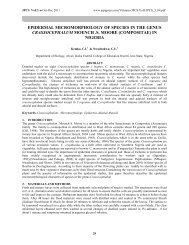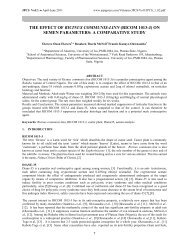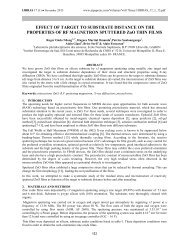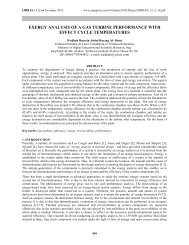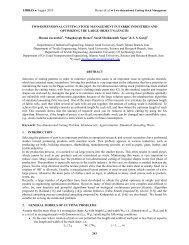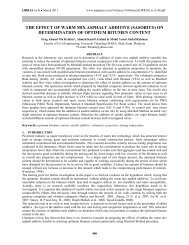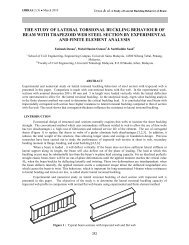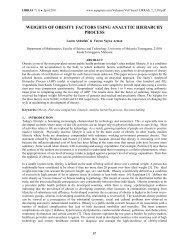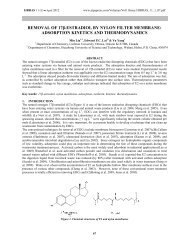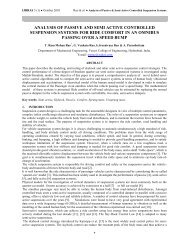elastic anisotropy of hcp metal crystals and polycrystals
elastic anisotropy of hcp metal crystals and polycrystals
elastic anisotropy of hcp metal crystals and polycrystals
You also want an ePaper? Increase the reach of your titles
YUMPU automatically turns print PDFs into web optimized ePapers that Google loves.
IJRRAS 6 (4) ● March 2011 Tromans ● Elastic Anisotropy <strong>of</strong> Hcp Metal Crystals <strong>and</strong> Poly<strong>crystals</strong><br />
3.3 Stiffness.<br />
The most important aspect <strong>of</strong> uniaxial strain conditions is the three dimensional stress state where the presence <strong>of</strong><br />
lateral tensile stresses allows no lateral strain contractions i.e. Poisson’s ratio is zero. This is readily evident from an<br />
examination <strong>of</strong> the stiffness (C) relationships in Eq. (8), leading to Eq. (9), for uniaxial strains <strong>and</strong> <br />
: ( <br />
1<br />
2<br />
3<br />
2<br />
: ( <br />
1<br />
: ( <br />
1<br />
3<br />
3<br />
2<br />
<br />
<br />
0)<br />
:<br />
0)<br />
:<br />
0)<br />
:<br />
C <br />
<br />
1<br />
2<br />
3<br />
C<br />
11 11<br />
11<br />
33<br />
<br />
2<br />
3<br />
467<br />
,<br />
,<br />
<br />
2<br />
1<br />
1<br />
C , C <br />
12<br />
C <br />
12<br />
13<br />
1<br />
2<br />
3<br />
,<br />
3<br />
3<br />
2<br />
13 1<br />
C <br />
C , C , C <br />
3.4 Young’s Modulus E <strong>and</strong> Rigidity (Shear) Modulus G.<br />
The tensile modulus E is the constant <strong>of</strong> proportionality between stress <strong>and</strong> strain under uniaxial stress loading as<br />
measured in the direction <strong>of</strong> the applied stress (i.e. a three dimensional strain situation). It has wide application in<br />
engineering design. Examination <strong>of</strong> the compliance (S) relationships in Eq. (8) under a uniaxial stress or 3<br />
yields the relationships shown in Eq. (10) where it is evident that E is the reciprocal compliance S -1 :<br />
: ( <br />
1<br />
2<br />
3<br />
2<br />
1<br />
: ( <br />
1<br />
3<br />
: ( <br />
3<br />
2<br />
<br />
<br />
<br />
0)<br />
:<br />
0)<br />
:<br />
0)<br />
:<br />
E<br />
E<br />
E<br />
( 21<br />
10)<br />
( 011<br />
0)<br />
( 0001)<br />
/ ( S<br />
<br />
3<br />
1<br />
2<br />
1<br />
/ <br />
3<br />
2<br />
( S<br />
/ ( S<br />
)<br />
1<br />
11<br />
1<br />
11<br />
)<br />
)<br />
1<br />
33<br />
<br />
<br />
<br />
1<br />
2<br />
1<br />
12<br />
12<br />
13<br />
2<br />
3<br />
13<br />
13<br />
S , S <br />
1<br />
2<br />
3<br />
3<br />
3<br />
2<br />
13<br />
S , S <br />
13<br />
S , S <br />
The subscripts ( 21<br />
10)<br />
, ( 011<br />
0)<br />
<strong>and</strong> (0001) in Eq. [10] refer to the crystal plane lying normal to the direction <strong>of</strong><br />
the uniaxial stress (see Figs. 3 <strong>and</strong> 4) <strong>and</strong> the corresponding E values are listed in Table 3.<br />
(0001)<br />
(0110)<br />
(2110)<br />
(1011)<br />
(a) (b) (c) (d) (e)<br />
13<br />
1<br />
2<br />
3<br />
(1121)<br />
Figure 4. Orientations <strong>and</strong> Miller-Bravais indices <strong>of</strong> principal planes in hexagonal <strong>crystals</strong> (a) basal plane, (b) primary<br />
prismatic plane: (c) secondary prismatic plane: (d) primary pyramidal plane <strong>and</strong> (e) secondary pyramidal plane.<br />
For uniaxial stresses <strong>and</strong> 3 the corresponding average Poisson’s ratios, 1 2 <strong>and</strong> 3 are obtained:<br />
(<br />
2<br />
3)<br />
(<br />
S12 S13)<br />
(<br />
1<br />
3)<br />
(<br />
S12<br />
S13)<br />
(<br />
2<br />
1)<br />
(<br />
S13<br />
S13)<br />
1 ; 2<br />
; 3<br />
; (11)<br />
2<br />
2S<br />
2<br />
2S<br />
2<br />
2S<br />
1<br />
11<br />
2<br />
The negative sign in the formulae for Poisson’s ratio in Eq. (11) is introduced because the lateral strains are usually<br />
contractions (negative strain) <strong>and</strong> it is conventional to express as a positive number. Note that the ratios <strong>of</strong> the two<br />
components S12/S11 <strong>and</strong> S13/S11 in <strong>and</strong> 2 are unequal leading to different lateral strains in orthogonal directions X1<br />
<strong>and</strong> X3 in the ( 21<br />
10)<br />
prismatic plane <strong>and</strong> orthogonal directions X2 <strong>and</strong> X3 in the ( 011<br />
0)<br />
prismatic plane (see Figs.<br />
3 <strong>and</strong> 4). Zinc is an unusual <strong>metal</strong> because S12 has a positive value (see Table 2) indicating that there is an expansion<br />
along the c-axis in the X3 direction on the prismatic planes (i.e. a negative <strong>of</strong> -S12/S11 = -0.075 in the X3 direction).<br />
Similar negative -values on prismatic planes <strong>of</strong> Zn have been reported previously [Lubarda <strong>and</strong> Meyers, 1999]<br />
Although uncommon, negative -values are not forbidden by thermodynamics <strong>and</strong> have been reported for several<br />
<strong>metal</strong> <strong>crystals</strong> <strong>of</strong> cubic symmetry when stretched in the [110] direction [Baughman et al., 1998] <strong>and</strong> in the mineral<br />
cristobalite [Yeganeh-Haeri et al. 1992]. Based on Eq. (11) average values <strong>of</strong> Poisson’s ratio 1 <strong>and</strong> 2 on the<br />
prismatic planes, <strong>and</strong> 3 on the basal plane, are listed in Table 3.<br />
Conditions <strong>of</strong> pure shear are produced under torsional loading where the stresses involved are readily seen by an<br />
examination <strong>of</strong> Figs. 1, 3 <strong>and</strong> 4. If torsion is produced on the ( 21<br />
10)<br />
prismatic plane by rotation around the X1 axis<br />
the shear stresses involved are 31 <strong>and</strong> 21 (i.e. 5 <strong>and</strong> 6 in the contracted notation). Similarly, torsion produced on<br />
11<br />
3<br />
33<br />
(9)<br />
(10)



